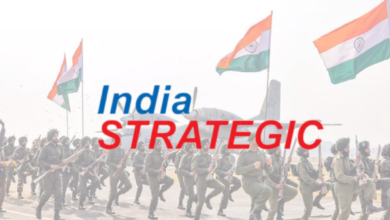Farnborough International Airshow, an Opportunity for India
The first airshow was held at Hendon in Britain in 1920, marking the impressive achievements of a number of aviation pioneers. Those were the super days when brave heroes among the mankind took to the skies in flying machines made of wood and as the power of engines progressively developed, aluminium was increasingly used.

The inspiring stories of those yesteryears can be seen by us in several films, particularly those made on World War II like the Battle of Britain, Squadron 633, Blue Max and so on. German and allied Pilots fought in visual range, and only a rogue would shoot down an ejecting pilot midair. The code of conduct was as strong as the inspiration of the early aviators.
The Airshow is being held at Farnborough since 1948, and is a big event now to showcase hi-tech developments in flying as well as onboard systems, which can enable a force to monitor what can be happening in hostile territory and also take action from faraway standoff positions. Various Manned, Unmanned and Space systems show newer and newer capabilities every year.
Every major aviation company, regional or global, private or state owned, is present at shows like this one. Besides political leaders, who are invested with powers to take decisions, top officials from various air forces from many countries take part in the Farnborough Airshow and similar events at Paris and elsewhere, including in India at Bangalore.
The reason is simple enough. An airshow is a one stop shop to witness the best available in civil and military technologies. You may not buy there and then, but you can have a reasonable idea to firm up your interest in accordance with your needs, says Vivek Lall, Chief Executive, Global Strategic Development for General Atomics. His company is there, touting sales of Predator series of unmanned aircraft, including the Predator C Avenger for which the Indian Government has recently approached the US Government. Some Predator aircraft can fly for about 35 hours.
Although a decision to sell sophisticated system or not lies with concerned governments, information is freely available on otherwise many classified systems at airshows. There is an opportunity for officers of armed forces, intelligence organisations, and even aircraft or smaller component manufacturing companies. The Indian presence at such air and defence shows is generally small but it is time to send at least a hundred or so personnel, including youngsters from companies like HAL, to such international events.
The sounds and sights at an airshow are always exciting, and visibility of modern technologies enormous. I have seen Airbus sending nearly 100 of its young employees to an airshow. Surely, for a country like India which is struggling to achieve distinction in aerospace, a similar initiative will literally go a long way in training youth for the future.
For a change, the young aviation engineers could be sponsored by both the public and private sector companies. If the Tatas and Mahindras want to attain heights, it would be only through the well-trained and well-inspired youngsters of today.
Gulshan Rai Luthra




